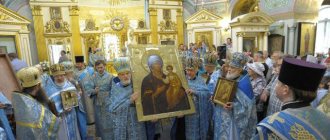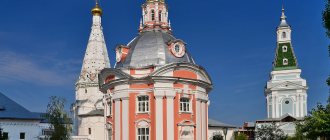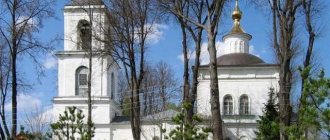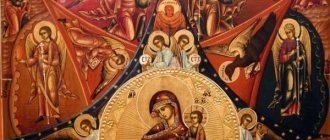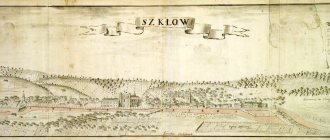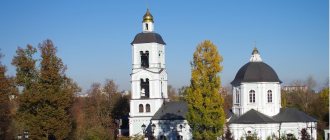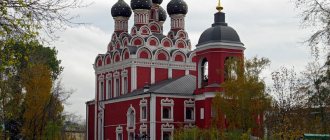Church of St. Theodore the Studite . The Church of the Ascension, located at the Nikitsky Gate, is known to many because A.S. Pushkin was married there. However, not everyone will pay attention to this modestly located church - it is too inconspicuous in the shadow of the Ascension Church.
The church was built in 1624. The shrine of the temple was the icon of St. Theodore, who was greatly revered in Rus'.
From the history of the church
Back in the 15th century, in the place where the temple stands today, there was a road leading from the Kremlin to Novgorod (later it would be called the Great Nikitskaya Road after the Nikitsky Monastery founded nearby).
The appearance of the temple in honor of the Monk Theodore the Studite at the Nikitsky Gate is associated with the flight of the famous Khan Akhmat: an event that went down in history.
It fell on the day of remembrance of the saint. Then only a chapel was built here in the name of Theodore the Studite. Later, a convent founded by Ivan III will also appear on this site.
It is likely that the Feodorovsky Church appeared at the same time and served as the cathedral shrine of the monastery. In any case, the temple is already mentioned in the chronicles telling about the fire of 1547 in Moscow.
According to another version, the church was built from an old chapel.
In 1624, Filaret (formerly Feodor Romanov) decided to build a temple, which became a cathedral. The shrine was held in special esteem by Filaret; it was even called the patriarch’s brownie. Here the patriarch sets up a hospital for the poor, one of the first in Moscow.
After the patriarchate was actually abolished, the further history of the Theodore Church is connected with the name of A.V. Suvorov. For the commander, it became a parish.
LiveInternetLiveInternet
Friday, April 23, 2010 13:49 + to the NADYNROM
all posts by the author
Church of St. Theodora Studite at the Nikitsky Gate, one of the oldest in Moscow, is located near the Church of the Great Ascension. It was built in 1626 by order of Patriarch Filaret, the father of Tsar Mikhail Fedorovich, and is known for the fact that at the end of the 18th century it became the parish church of Alexander Vasilyevich Suvorov. Earlier, in the 15th-16th centuries, the main road from the Kremlin to Veliky Novgorod passed here. The name “Bolshaya Nikitskaya” was given to it after the ancient Nikitsky monastery, founded at the end of the 16th century by Nikita Zakharyin-Yuryev, the father of Patriarch Filaret and the grandfather of Tsar Mikhail Fedorovich. (The monastery was located on the left side of the street on the site of building No. 7, where the gray bulk of a metro electrical substation now stands.) The church appeared here much earlier. On the day of remembrance of Rev. Theodore Studite (November 11, old style) witnessed the famous flight of Khan Akhmet from the Ugra River and the fall of the Tatar-Mongol yoke. Then, at the end of the 15th century, the chapel of St. Theodore the Studite with the icon of the Smolensk Mother of God. And soon, in memory of the deliverance from Khan Akhmet on the Ugra, Ivan III founded a convent here. It is possible that at the same time the Feodorovskaya Church appeared, which was originally the cathedral church of this monastery. At least, the chronicle mentions it already in the description of the Moscow fire of 1547. The main altar of the church was consecrated in honor of the Smolensk Icon of the Mother of God, and the chapel - in the name of St. Theodora Studite. Another version says that Patriarch Filaret built this church from an ancient chapel. It is possible that the former church had burned down or was badly damaged by that time. What is known for certain is that, according to the Smolensk icon, both the monastery founded by Ivan III and later the nearest gate of the White City (the future Nikitsky) were called Smolensky. In 1619, Theodore Nikitovich Romanov, Patriarch Filaret, was greeted at these gates from Polish captivity. Apparently, the clergy met him here, since the father’s meeting with the royal son took place earlier, at Presnensky Ponds. Upon the return of Patriarch Philaret, the Smolensky monastery became a men's monastery and was renamed Feodorovsky - in honor of St. patron of the patriarch. At the same time, in 1624-1626. Filaret built a church of the same name here, which, as in the old days, became the cathedral church of the monastery. It is possible that it was actually rebuilt from a chapel that had survived until that time and was dedicated to the heavenly patron of Patriarch Philaret, in whose honor he built the church itself. It became his favorite place of calm and relaxation. So that the temple was even considered the patriarchal brownie, like the “official” Church of the Deposition of the Robe in the Kremlin. In the new monastery at the Nikitsky Gate, at the expense of the patriarch, one of the first hospitals in the city for the poor with a pharmacy was established. Previously, such benefits were available only to noble persons of the state. Only in 1709 this monastery was abolished, and the monks were transferred to the Novinsky Monastery. And since 1712, the Feodorovskaya Church became an ordinary parish church, as it is now. Although not quite ordinary - at the end of the 18th century, its parishioner was A.V. Suvorov. In 1775 - 1800 he lived nearby in his family home (No. 42) on Bolshaya Nikitskaya. On the wall of the house there is a memorial plaque with the inscription: “Suvorov lived here,” as modest and ingenious as the tombstone epitaph on the commander’s grave in St. Petersburg.
I. Kreutsinger.
Portrait of A.V. Suvorov in the uniform of the Preobrazhensky Guards Regiment. 1799 It is known that Suvorov was distinguished by devout piety. In the church of Theodore the Studite, he himself read the Apostle and always especially remembered his parents when he left Moscow. Both Suvorov’s mother and all of Suvorov’s relatives were buried at this church. Suvorov also prayed in the neighboring Church of the Great Ascension, even before its famous reconstruction. Eyewitnesses have preserved memories of how he, having made three bows to the ground in front of each local icon, lit a candle, served prayers on his knees and tremblingly approached the blessing. And when Suvorov came to receive Empress Catherine the Great, he, too, first made three prostrations before the image of the Kazan Mother of God, and then bowed to the ground to the Empress, who did not want this and raised the commander by the hands: “Have mercy, Alexander Vasilyevich, shame on you.” do it!" However, Suvorov, a native Muscovite, was born not on Nikitskaya Street, but on Arbat, on the corner with Serebryany Lane. Now it is almost forgotten that this lane was previously called Manukov, after the name of the homeowner, St. Petersburg judge F. Manukov. When his daughter married Lieutenant of the Preobrazhensky Regiment V. Suvorov, he gave his Arbat house to her as a dowry, where the greatest Russian commander was born. The breakup between Suvorov and Paul I after the death of Catherine is known. When Pavlov’s military reform in the Prussian style began, Suvorov said: “The Russians always beat the Prussians, so what can we adopt?” And when he received sticks for soldiers’ braids and braids, he said: “Powder is not gunpowder, braids are not guns, a scythe is not a cleaver, I am not a German, but a natural Russian.” And this is precisely what caused the quarrel between the emperor and the commander. Little is known about their other, almost mystical, last farewell in St. Petersburg. When Suvorov died, Pavel rode to the house on horseback (and the Generalissimo died in the house of his relative, Count Khvostov, on Nikolskaya Embankment) and waited in the courtyard for the coffin to be carried out. But the coffin still did not pass along the old narrow staircase, and the eccentric, nervous emperor galloped away without waiting. The coffin could not be carried up the stairs - it was lowered by rope from the balcony. And Pavel met the funeral procession already on Nevsky Prospect, on the way to the Alexander Nevsky Lavra, which became the last refuge of Suvorov. There again something strange happened that became legendary. The coffin did not pass through the door of the Annunciation Church, where the funeral service and burial of the commander was to take place. And then one of the soldiers carrying the coffin commanded: “Forward, guys! Suvorov passed everywhere!” - and they passed with an onslaught. On the grave there is a bronze plaque with the famous epitaph: “Here lies Suvorov.” According to one legend, Suvorov himself composed it for himself, and according to another, the poet Derzhavin. It’s as if he visited Suvorov before his death and he asked him what epitaph he would write for him? “You don’t need a lot of words - “here lies Suvorov,” Derzhavin replied. “God have mercy, how good!” - the commander exclaimed with delight. Perhaps it became the prototype for the memorial inscription on the wall of Suvorov’s Moscow house. At one time there was an idea to open his museum here. And in 1950, when the 150th anniversary of the commander’s death was celebrated, the nearby Nikitsky Boulevard was renamed Suvorovsky. And after the revolution, a scientific institution was located in the Feodorovskaya Church. The 17th-century tented bell tower was demolished. Now services are held in the temple again, and a memorial plaque on its walls says that Suvorov was once a parishioner of this church. An article by Elena Lebedeva is quoted. And now, having offered to look at how the temple looked in a pre-revolutionary photograph from Naydenov’s album, I want to add something of my own.
The temple was badly damaged in 1812. Then the five-domed structure (and the temple was originally five-domed!) was replaced with a dome covering with one dome. The bell tower of the temple was considered one of the first tented ones in Moscow. It was demolished in the 30s, and a residential building was built in its place. In 1984, restoration of the temple began. There were thoughts about opening a Suvorov museum in it, but in the end it was returned to believers. I can assume that it was the name of Suvorov that saved the church building from demolition. During the restoration, the five-domed structure was returned. I'm happy about it. And the bell tower was rebuilt, albeit not in the same place, but in the same forms.
| Categories: | history architecture |
Tags:
Temple of Theodore the Studite at the Nikitsky Gate, Moscow
Cited 4 times
Like share
0
Like
- I liked the post
- Quoted
- 0
Saved
- Add to quote book
- 0
Save to links
Liked
0
Temple after the revolution
In 1927 (according to another version - in 1929) the temple was closed, and a scientific institution was located within its walls.
The white-stone, tent-type bell tower, once the second oldest in Moscow, was demolished. Today you can only see the basement - all that remains of the once glorious building.
The area near the Nikitsky Gate was supposed to be filled with multi-story buildings, so the temple was planned to be demolished. However, demolition did not happen.
In 1984, the damaged building of the shrine began to be restored. At first they wanted to open a Suvorov museum within its walls, but in the end the temple was consecrated again.
Since 1991, continuous worship services have been held here. A plaque on the wall of the church reminds that the great Suvorov was once a parishioner of the Feodorovsky Church. Today there are few parishioners near the temple, because, despite its location in the city center, the shrine is surrounded mainly by institutions and offices. However, believers who visit the temple try to contribute to its restoration and improvement. Bit by bit, the former appearance of the ancient shrine is being restored.
The Temple of St. Theodore the Studite at the Nikitsky Gate is located at the address: Moscow, Bolshaya Nikitskaya, 29, building 2 (Arbatskaya metro station).
Abbots
From 1998 to 2021, the rector of the Temple of Theodore the Studite was Hegumen Ermogen. He currently holds the title of honorary rector.
From 2021 until his death in January 2021, Vsevolod Chaplin was the rector of the Church of Theodore the Studite. He became widely known for his work as chairman of the Synodal Department for Interaction between Church and Society of the Moscow Patriarchate and for his resonant statements on various issues.
The clergyman of the church is also Archpriest Alexy Fokin.
Panorama of the approach to the Temple of Theodore the Studite from Bolshaya Nikitskaya Street
Church "St. Teodor Tyrone and St. Theodore Stratelates" - Dobarsko village
If you've only heard about this church but never visited, your first impression when approaching it will likely be a bit of a disappointment. The Orthodox church is unobtrusive , small and does not attract attention.
In fact, there is an explanation for the construction of the church, and it is quite logical. According to current official documents, the church was built in the 17th century (1614), and this is the period when our country was under the rule of the Ottoman Empire. According to Turkish laws in force at that time, Christian churches could not be larger or higher than Turkish churches. For this reason, local residents from the village of Dobarsko dug the temple into the ground, did not put a dome and bell tower on it, and they adhere to the requirement of small size.
Thus, when a Turk passed by the church, he could not even notice it, because from the outside it looked more like a simple stone building of small dimensions (8.37 meters long, 6.5 meters wide and 5.2 meters at its highest part ).
Did you notice that when we mentioned the year the temple was built, we indicated that according to existing official documents it was 1614? Officially this is the year it was built, but...
According to some prominent Bulgarian historians and archaeologists (including Professor Bozhidar Dimitrov), the church was built during the First Bulgarian Kingdom. In defense of their theory, historians point to three very important facts:
- Inside the temple there is a slab sunk into the floor, and on this slab the year 1122 is clearly written;
- The church is a three-nave basilica, and this structure is typical of churches that were built during the First Bulgarian Kingdom;
- By the end of the 18th century, the village of Dobarsko was an important religious, economic and cultural center, and it is unlikely that local residents would begin to build their own church centuries after Christianity entered our country.
There is another theory, (we repeat), just a theory, according to which a dug slab with an earlier engraved year indicates that there was an old church on the site of today's temple, and during construction in 1614, builders built in the slab in the new church as a sign continuity.
We leave here the dispute regarding the exact date of construction of the building, and once again look at the church from the outside. You also have to do this very carefully and you will notice a carved Christian cross on one of the outer walls, and on the other wall you will see... a swastika.
It is understandable to have a transverse symbol on the façade, but why a swastika?
Historians have their own theory of the swastika , and most likely the swastika stone was most likely brought from the Proto-Bulgarian capital and built during the construction of the church to show continuity between generations.
You haven't entered the church yet, but the stories, theories and legends are becoming more and more...
The name of the church is also of great interest, since it turns out that this is the only church in the country that is named after two warriors - St. Teodor Tyrone and St. Theodore Stratilates . Unusual and strange, right?
The moment you enter the small, seemingly simple church, you will forget the world around you. This is absolutely true, because we know that you will be completely stunned and amazed by the interior.
The first thing that will leave you speechless is the fact that such a small temple can be painted with more than 460 images. Literally every meter of the temple, a total of 160 square meters, is painted with biblical images and paintings of local heroes.
And this is not even the strangest and most unusual thing, but the way the images are depicted! Only here you can see images of St. George and St. Demetrius not on a horse, but in full growth, only here you can see more than 30 images of female saints (something that is absolutely uncharacteristic of that time), only here you can see the twelve apostles again depicted in full height (something rarely seen in our country).
You will also see images of the holy brothers Cyril and Methodius, and their images, according to historians, were depicted during the time of the fist in this church.
And you haven't seen the most interesting thing yet. What attracts thousands of tourists and has caused controversy among historians for many years is how icon painters depicted the scene of the Transfiguration of the Lord .
The path of Jesus Christ is depicted causing a crow of DS tourists to come to the church “St. Theodore Tyrone and St. Theodore Stratilates” - in the village of Dobarsko to see the image and not believe their eyes. Because in this scene, Jesus Christ appears to be in a spaceship (rocket).
There is another "cosmic" scene in the temple, and this is the "Resurrection of the Lord", where Christ appears to be in a space capsule, and this scene causes great surprise and impression.
If you look closely at the pictures of saints, you will find a picture of St. Paul that is drawn in such a way that no matter what part of the church you are in, his eyes will always be looking at you.
Unfortunately, at that time, icon painters did not write their names under their works due to the belief that they were not real artists, but God does this by moving his hands, so at present there is no information about the name of the icon painter who painted so brilliantly temple, but experts believe that these frescoes were made by a whole team, which included a master, students and an apprentice.
And another theory...
Since the images of women painted in the temple are 30 years old, and this was not accepted in the past, experts believe that one of the icon painters was a woman. This is very difficult to prove, because in these centuries the idea of a woman cultivating such an art was completely unthinkable, but the theory is intersting, and that is why we want to share with you.
Do you think that the miracles of the church “St. Theodore Tyrone and St. Theodore Stratelates” in the village of Dobarsko will ultimately be here? Don't rush so much!
The construction of the church itself is amazing because no matter the weather conditions outside the temple, the temperature inside is always the same... as if there was air conditioning. The constant temperature, lack of windows and candle smoke preserved the frescoes for centuries, and when a team of restorers came to the temple between 1973 and 1976, they discovered that restoration of the frescoes was not necessary.
The experts simply cleaned the frescoes, removing the accumulated soot, and the images of the saints became as bright as if the icon painters had just finished working on them and left.
When you are done with the church and decide to leave, take your time and stroll through the beautifully landscaped churchyard full of flowers. And there, next to the flower beds, you will see a small spring (holy spring) , there are even legends about it. Wash your face because, according to legend, the water in the holy spring is healing, and then toss a coin for good health.
Temple of Saint Theodora
Saint Theodoa - a girl who turned into a church
Not far from the village of Vasta, which is located in the Peloponnese, there is an attractive place - both tourists and the Greeks themselves admire it. 17 large and small trees grow from the roof of the Church of Agia Theodora. Their roots cannot be seen either outside or inside the church. Perhaps they pass through stone walls, due to which some consider such a phenomenon to be a divine miracle, others - a natural miracle.
The Girl Who Turned into a Church: The Legend of Saint Theodora
The history of the appearance of the church is no less interesting than its appearance. During Byzantine times, conscription was in force. And all families, without exception, were obliged to send one soldier to serve or pay a huge tax. According to legend, the girl Theodora once lived in this area. Having pretended to be a man, she joined the army - there were no brothers in Theodora’s family, and her father was already old.
She served bravely and gained respect until one day disaster struck. Another girl fell in love with her without knowing the whole truth. Rejected by Theodora, she decided to take revenge by accusing him of refusing to marry. Theodora had two options: marry or sacrifice herself. It is quite obvious that she chose the second option. According to another version, the girl renounced the world and passed herself off as a man in order to become a monk. And she was executed because of slander from another girl, who lied that the “monk” showed feelings for her.
In her last words, Theodora wished that her “body would turn into a temple, her hair into trees, and her blood into streams.” The story of the unjustly killed girl haunted local residents for many years. The main sign for them was the appearance of a spring at the place of execution. And in the 12th century it was decided to build a church here.
Church today
The Church of Agia Theodora is located in an overgrown ravine, among a dense forest. The idyllic location impresses without exception anyone who comes here. Each tree that grew through the roof of the church, according to conservative estimates, weighs more than a ton, exceeds 30 meters in height and has almost no age-related damage. A spring still flows underground, which, according to one version, feeds the trees. Some foreign and Greek scientists even tried to find tree roots within the walls of the church. But such studies did not yield any results - trees seem to grow out of nowhere. There is also no answer to the question of how a dilapidated and tiny church can withstand the growth of roots.
Inside, the church looks more than modest. Walls with traces of past centuries, an altar and several icons - that’s all its decoration. However, at any time of the year, thousands of pilgrims come here to light candles, buy a talisman and ask Saint Theodora for a blessing. And miracles really do happen. It is said that after praying and bathing in the spring, many desperate families were able to have children. A trip to church is often combined with a vacation. From Agia Theodora you can walk along the path to enjoy the silence and fresh air. At the end of the trail there is a kind of recreation area with small shops and cafes.
